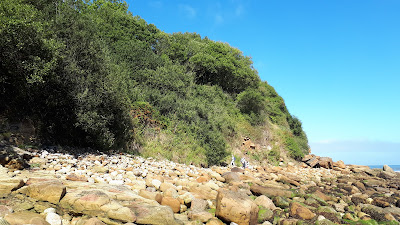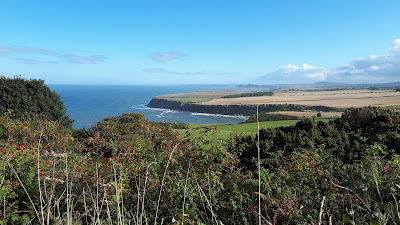A Saturday outing with Hull Nats to Hayburn Wyke in North Yorkshire. We had a downpour when leaving Hull, but the weather kept improving and we had a mostly sunny afternoon with barely any wind. My main aim for the day was to try and see Dark Bush-crickets, which have their most northernmost outpost on the east coast in this sheltered cove. We did a circular walk, starting at Hood Lane, walking north on the old railway line from Scarborgouh to Whitby, the Cinder Track, then going down on the steep track to the cove, where we had lunch and returning by the Cleveland Way. Our glacial pace of advance along the Cinder Track was a sure indicator of the rich flora of the area. Bird wise, we came across several Marsh Tits and two Treecreepers in mixed species flocks.
A Wigeon and a Teal were feeding in a wetland by the Cinder Track.
We descended into the ravine that ends in the cove. Wyke comes from vik, meaning bay or inlet in Old Norse (as an aside, this word also gave name to the old settlement at the mouth of the River Hull now known as the city of Hull). The banks of the ravine are otherwordly, clothed by a damp woodland with a profusion of ferns and mosses. It is a magical place, reminiscent of Danes Dyke but at a larger scale. The trees are not particularly old, as they were felled during WW2, but the National Trust, who now owns the land, is restoring the woodland. We descended the steep path to the cove, which are well maintained, often with stone steps.



Eventually we heard the noise of the breakers and we emerge at a small cliff, where the creek ends in a small waterfall and a boulder and pebble beach. I had been pulling ahead to try and get to the beach during a sunny spell. I had been told that the Dark Bush crickets favoured the SE facing slopes covered in scrub and woodland, so I headed to the bottom of the scrub on the beach.
The waterfall onto the beach.
My first attempt at checking the base of the cliff vegetation ended in failure. It was tricky to search for anything while navigating the boulders. But then, Bill Dolling reached the cliff and said 'I'm sure that's where they are', and within a couple of minutes he pointed at one, clinging to a stem of grass.
My first Dark Bush Cricket.
The individual, a male, posed patiently for us.
From a distance, their colour pattern, size and general shape are reminiscent of a young toad.
The second male we saw.
I was very pleased to spot this Common Lizard at eye level at the base of the cliff.
The Dark Bush cricket colony location. I imagine they must be common in many other areas on the cliffs, but they are very steep and mostly inaccessible.
Hayburn Wyke beach
The cliffs look very wild, clothed in lush vegetation.
Flowering Wood Vetch, Vicia sylvatica
The beautiful foliage of Wood Vetch.
This hoverfly, Leucozona glaucia, a new species for me.
Field Grasshopper, Chorthippus brunneus.
Comma, the only one we saw. There were plenty of Speckled Woods and a single Holly Blue.
An inaccessible shelf on the cliff.
Cloughton Wyke and Scarborough Castle in the distance.






















1 comment:
Thanks for some splendid pictures. The side view of the Dark Bush Cricket on a mushroom is particularly fine.
Post a Comment